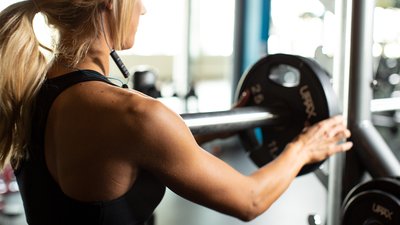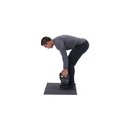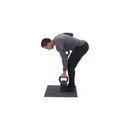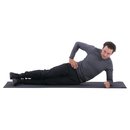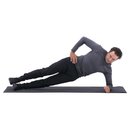These are common complaints heard throughout the gym as trainees grunt their way through all four sets of one exercise before moving onto the next. Before they know it, a solid hour and a half passes, and they still have three more exercises to go.
Enter supersets. They aren't a new, magical fix. It's actually possible to use them improperly, and make your workout less effective as a result. But done right, they can enhance an already-sound training program and get you out the door and on with your life.
Supersets are appropriate for just about any person in the gym looking to make the most of their time, especially people who are easily distracted on the training floor. Supersets keep idle hands busy.
But look around online, and you'll see the term "superset" used so loosely that you may not know what one really is. So let's start at square one.
What are Supersets?
Supersets are a training scheme in which one set of one type of exercise, often titled "A1" in a program, alternates with another, titled "A2." To perform one superset, you perform the prescribed reps of A1 followed by those in A2. Take, for example, the following setup:
A1. Goblet Squat, 4 sets, 6-8 reps, 60-second rest
A2. Pull-up, 4 sets, 6-8 reps, 60-second rest
Grab a kettlebell or dumbbell and bang out between 6-8 reps (remember, if you feel like you could have completed 2-3 more good reps, it's time to step up in weight). When you're done, rest for approximately 60 seconds before moving onto the pull-up for 6-8 reps. That's one complete superset. After another 60 seconds, make your way back to the goblet squats to begin set 2.
You might be surprised to see that rest period after the goblet squats, since many people think of supersets as two exercises with little or no rest in between. I think of the bang-bang approach as more of a metabolic circuit than a strength superset, and I'd prescribe it as a conditioning workout in lieu of steady-state cardio.
For strength building, I like taking slightly longer rest periods to ensure that I'm feeling fresh for my next set. For example, I wouldn't be able to do as many pull-ups if my heart was still racing from the heavy goblet squats immediately prior.
What They're Super at
Consider the above superset. Imagine, if you will, the amount of time it might take to finish the two movements without supersetting them:
A. Goblet squats, 4 sets of 6-8 reps, 120-second rest
B. Pull-ups, 4 sets of 6-8 reps, 120-second rest
For this example, we'll assume that each set takes 25 seconds to complete, and we'll omit any warm-up sets for the sake of simplicity. Adding this all up, the time required to get through this would be 4(25s) + 4(120s) + 4(25s) + 4(120s) = 1,160s, or 19 minutes and 20 seconds. On the other hand, a superset would take 4(25s) + 4(60s) + 4(25s) + 4(60s) = 680s, or 11 minutes and 20 seconds.
That's eight extra minutes you have on your hands. You'll get home to your kids eight minutes earlier. You'll make it to your business meeting on time. Or perhaps you want to use those newfound minutes to fit in some foam rolling in at the beginning or end of your session. Add in another superset with similar parameters, and you save 16 minutes.
You can thank me later. But I'd be satisfied if you just foam rolled instead.
Supersets are all about improving your training density: the amount of work completed within a given time frame. Increased training density is great not only because are you being efficient, but because you're also moving more.
Think about it: one set here, followed by one set way over there, and then back to the starting point. Then repeat. Supersets are one of the most simple and effective ways to increase your training density-provided that the correct movements are paired together, of course.
Build a Super Superset
Exercise selection is crucial. Far too often, I see individuals in the gym arbitrarily throw together a pair of exercises that do more harm than good. Pairing a deadlift with pull-ups, for example, would be a poor choice, because both exercises absolutely fry your grip.
The same goes for pairing dumbbell lunges or single-leg squats with dumbbell rows. The quickly-accumulating fatigue will compromise the quality of the entire superset. You will feel drained, and you'll also pull less weight and bang out fewer reps.
Good supersets generally fall into two camps: antagonist or non-competing. Look around online, and you'll see plenty of people who use the term superset to describe any pairing of exercises, including two movements that target the same muscle group, like, say, military presses and side delt raises for shoulders.
This is actually a "compound set," whereas the standard antagonistic supersets are more like this:
A1. Horizontal push
A2. Horizontal pull
A1. Vertical push
A2. Vertical pull
Biceps with triceps is a common antagonistic superset. You can also superset a horizontal push with a vertical pull—such as push-ups with pull-ups—or a vertical push with a horizontal pull.
Alternatively, a non-competing superset can look like this:
A1. Squat
A2. Upper body pull
A1. Hip hinge
A2. Upper body push
Some trainers trend toward one or the other methodology, but I think of antagonistic and non-competing supersets as two sides of the same coin. I prescribe antagonistic supersets for someone on an upper/lower training split, which usually involves training 4-5 days per week. Non-competing supersets, on the other hand, are perfect for full-body sessions performed 3-4 days per week.
With full-body workouts, you want the movements to be as non-competing as possible, so you can effectively use each half of the superset as a rest period for the other. This is why it's not appropriate for every exercise to be matched with an equally-taxing movement—like max deadlifts and heavy benching. Keep in mind that the quality of each set for each exercise should be kept as intact as possible.
You should also take into account the setup of your gym and the general environment there. Does it make sense to take over both the squat rack and the pull-up bar at the same time? If there's a power cage with pull-up bars, that might be your solution.
Do you normally train at a busy hour when people aren't going to be thrilled with your equipment-hogging, or do you have free reign over everything? Be willing to be flexible with both where and how you perform your supersets.
Common Questions
If I step out of the squat rack for a second, that guy over there is going to steal it. How do I incorporate supersets without losing my spot?
If equipment access is a problem, you could use it as an opportunity to seamlessly incorporate mobility and band-work into your program. If you want to work on mobility—this should be all of you!—and you don't particularly care for devoting an entire session solely to hip flexor drills, then mobility drills might be just the thing.
If you have cranky shoulders or stiff ankles like I do, then shoulder stability or ankle mobility drills would pair well with your heavy deadlifts or squats.
Can I superset isolation exercises?
Technically you can, yes. But just as with any smart programming, compound movements should take priority, which means that squats come before curls. If you're a believer in isolation exercises, leave them for last. Then you can go to town on them.
I feel like I haven't done enough if my workout is under an hour. Can I do more?
The point of supersets isn't necessarily to jam more work into more time. Remember that more isn't always better; better is better. But if feeling the pump and living in the gym is your thing, then have at it.
Can I superset more than two exercises?
Of course. A tri-set of three strength movements can work just as well as a superset, provided the movements follow the same guidelines I noted earlier. Or you could pair two exercises together and follow them immediately with a mobility drill. Four exercises executed in sequence is known as a giant set.
That may sound like a circuit, but as I mentioned earlier, a circuit moves more quickly, and with little to no rest. They're great for fat-burning, but if you want to build muscle, don't rush it.
Those rest periods bug me. Can I reduce them?
That depends on your goal and the exercise. If you do heavy deadlifts, I think it's important to rest for 3-5 minutes between sets. With supersets, this time can be split up to incorporate something like push-ups (upper-body push) or maybe some wall hip flexor mobilizations.
That said, I think it is overkill to hawk-eye the clock and insist on starting your next set right on the dot. Take a breather! When you feel like you're ready to get in another clean set, let 'er rip.
Sample Training Program
Do you need a little direction to set up your first superset training program? You can borrow one of mine. This one's a two-day full-body split to perform three times per week with at least one full day between each session.
Your first two weeks might set up like this:
Week 1
- Monday: Training Day 1
- Wednesday: Training Day 2
- Friday: Training Day 1
Week 2
- Monday: Training Day 2
- Wednesday: Training Day 1
- Friday: Training Day 2
And so on. As with any other training program, you should stick with this for 4-6 weeks before moving on to a new program.

BodyFit
$6.99/month- 2,500+ expert-created single workouts
- 3,500+ how-to exercise videos
- Detailed workout instruction
- Step-by-step workout tips
- Training at gym or at home
- Access to Workout Plans
- Access to Bodyfit App
- Store Discounts
Already have a Bodybuilding.com account with BodyFit? Sign In

What comes with BodyFit?

- Instructional Videos
Don't risk doing a workout improperly! Avoid injury and keep your form in check with in-depth instructional videos.

- How-to Images
View our enormous library of workout photos and see exactly how each exercise should be done before you give it a shot.

- Step-by-Step Instructions
Quickly read through our step-by-step directions to ensure you're doing each workout correctly the first time, every time.

BodyFit
$6.99/month- 2,500+ expert-created single workouts
- 3,500+ how-to exercise videos
- Detailed workout instruction
- Step-by-step workout tips
- Training at gym or at home
- Access to Workout Plans
- Access to Bodyfit App
- Store Discounts
Already have a Bodybuilding.com account with BodyFit? Sign In

What comes with BodyFit?

- Instructional Videos
Don't risk doing a workout improperly! Avoid injury and keep your form in check with in-depth instructional videos.

- How-to Images
View our enormous library of workout photos and see exactly how each exercise should be done before you give it a shot.

- Step-by-Step Instructions
Quickly read through our step-by-step directions to ensure you're doing each workout correctly the first time, every time.


